Recent Mold Remediation Posts
Mold Prevention Tips in Madison, Wisconsin
9/24/2021 (Permalink)
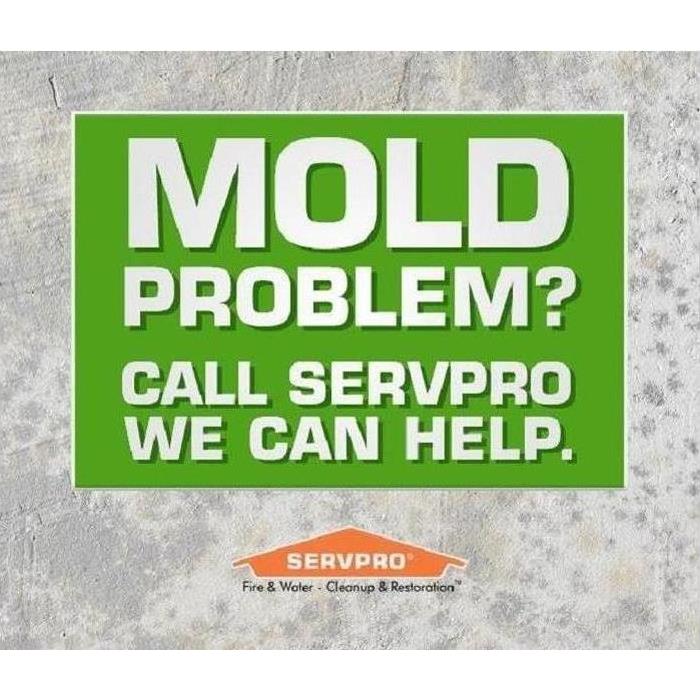 If You See Signs of Mold,
Call SERVPRO of Dane County West Today – (608) 497-3331 Proudly serving Madison, WI.
If You See Signs of Mold,
Call SERVPRO of Dane County West Today – (608) 497-3331 Proudly serving Madison, WI.
Mold, the Good and Bad Near You
Mold can be good — it's essential in making brie and penicillin, for example, and necessary for the decomposition of organic matter in nature — but it can also be bad, especially when it grows undetected in your home or business.
Mold can grow anywhere: on carpet, clothing, food, paper, and even in places you can't see, such as the backside of drywall, areas inside walls around leaking or condensing pipes, and above ceiling tiles.
If mold is left untreated, it can may cause health effects.
So what can you do if you're concerned about mold growing in your home?
The best approach is preventing mold before it becomes a problem. The key to mold prevention is simple: moisture control.
Here are nine ways to curb moisture indoors, and the mold that thrives on it.*
1. Identify problem areas in your home and correct them. You can't mold-proof your home, but you can make it mold-resistant. Do an audit of your home: where are the problem areas? Does the basement flood? Do you notice frequent condensation on an upstairs window? Is there a water stain on the ceiling from a persistent leak? Preventing mold from growing or spreading might be as simple as ripping up carpet in a damp basement, installing mold-resistant products, or repairing damaged gutters. Or it may be a matter of major excavation and waterproofing. Whatever the case, address the problem now. It might cost some money upfront, but it will surely be more costly down the road if mold continues to grow unchecked.
2. Dry wet areas immediately. Mold can't grow without moisture, so tackle wet areas right away. Seepage into the basement after heavy rainfall, accumulation from a leaky pipe, even a spill on the carpet should be dried within 24 to 48 hours. If you've experienced a flood, remove water-damaged carpets, bedding, and furniture if they can't be completely dried. Even everyday occurrences need attention: don't leave wet items lying around the house, and make sure to dry the floor and walls after a shower. Don't leave wet clothes in the washing machine, where mold can spread quickly. Hang them to dry — preferably outside or in areas with good air circulation.
3. Prevent moisture with proper ventilation. It may be that your routine domestic activities are encouraging the growth of mold in your home. Make sure an activity as simple as cooking dinner, taking a shower, or doing a load of laundry doesn't invite mold by providing proper ventilation in your bathroom, kitchen, laundry room, and any other high-moisture area. Vent appliances that produce moisture — clothes dryers, stoves — to the outside (not the attic). Use AC units and dehumidifiers (especially in humid climates), but make sure they don’t produce moisture themselves by checking them periodically and cleaning them as directed by the manufacturer. Your energy-efficient home may be holding moisture inside, so open a window when cooking or washing dishes or showering, or run an exhaust fan.
4. Equip your home with mold-resistant products. Building a new home or renovating an old one? Use mold-resistant products like mold-resistant drywall or mold-resistant Sheetrock, and mold inhibitors for paints. Traditional drywall is composed of a gypsum plaster core pressed between plies of paper. Mold-resistant drywall is paperless — the gypsum core is covered in fiberglass, making the surface highly water-resistant. Moisture-resistant drywall is especially valuable in areas prone to wetness, such as bathrooms, laundry rooms, basements, and kitchens. Not only is traditional drywall more susceptible to mold than the paperless kind, but it is also difficult to rid of mold. Mold-resistant gypsum board is also available; the core of the drywall is developed in such a way to prevent moisture absorption, and thus prevent mold growth.
5. Monitor humidity indoors. The EPA recommends keeping indoor humidity between 30 and 60 percent. You'll also be able to detect high humidity by simply paying attention to potential problem areas in your home. Telltale signs of excessive humidity include condensation on windows, pipes, and walls. If you notice condensation, dry the surface immediately and address the source of moisture (for example, turn off a humidifier if water appears on the inside of nearby windows).
6. Direct water away from your home. If the ground around your home isn't sufficiently sloped away from the foundation, water may collect there and seep into your crawlspace or basement.
7. Clean or repair roof gutters. A mold problem might be a simple matter of a roof that is leaking because of full or damaged gutters. Have your roof gutters cleaned regularly and inspected for damage. Repair them as necessary, and keep an eye out for water stains after storms that may indicate a leak.
8. Improve airflow in your home. According to the EPA, as temperatures drop, the air can hold less moisture. Without good airflow in your home, that excess moisture may appear on your walls, windows, and floors. To increase circulation, open doors between rooms, move furniture away from walls, and open doors to closets that may be colder than the rooms they’re in. Let fresh air in to reduce moisture and keep mold at bay.
9. Keep mold off household plants. They're beautiful and help keep your indoor air clean — and mold loves them. The moist soil in indoor plants is a perfect breeding ground for mold, which may then spread to other areas of your house. Instead of getting rid of your plants, try adding a bit of Taheebo tea to the water you give to your houseplants. The oil of this tree, which withstands fungi even in rain forests, helps hinder mold growth in plant soil and can be found at natural food stores.
*tips from MNN
If You See Signs of Mold,
Call SERVPRO of Dane County West Today – (608) 497-3331
SERVPRO of Dane County West Mold Remediation
Mold Management - A "Typical" Mold Removal Process
1/20/2021 (Permalink)
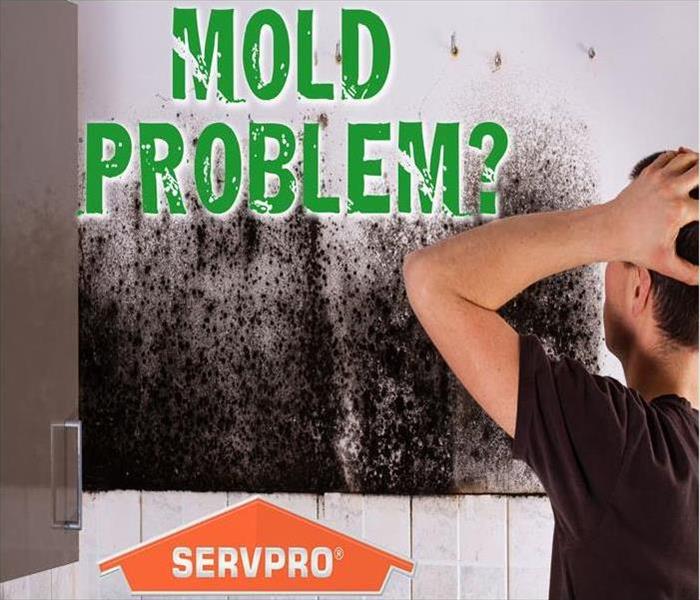 If You See Signs of Mold, Call SERVPRO of Dane County West Today – (608) 497-3331 #SERVPROdanecountywest #spdcw #heretohelp
If You See Signs of Mold, Call SERVPRO of Dane County West Today – (608) 497-3331 #SERVPROdanecountywest #spdcw #heretohelp
MOLD Management
When there's a water intrusion, like a roof leak or leaking water line, mold can quickly become a problem in your home or business. Mold can cause health effects and can also cause significant damage to your property. Fortunately, SERVPRO of Dane County West has the training, protective gear, and specialized equipment necessary to handle your mold problem. Although every mold damage scenario is different, requiring a unique solution, the general mold remediation process stays the same. The following steps illustrate a "typical" mold removal process.
Call your local SERVPRO Professional - SERVPRO of Dane County West.
The mold cleanup and restoration process begin when you call SERVPRO. A representative will ask a series of questions to determine the necessary equipment, resources, and personnel needed.
Inspection and Damage Assessment
Your property will be carefully inspected for mold signs using technology designed to detect mold and hidden water sources. Mold feeds on cellulose and water and can be hidden from plain view.
Here at SERVPRO of Dane County West, we highly recommend that our customers engage Industrial Hygienists/Environmentalists to detect exactly where microbial growth may be found in their homes. This is a partnership we strongly recommend and is mutually beneficial for our customers.
Industrial Hygienists/Environmentalists are specialists who tend to approach indoor mold conditions primarily from a scientific perspective. They are trained to take air samples and surface samples of visually apparent mold and develop a protocol for the remediation process.
Once a customer has a sample analysis completed, SERVPRO of Dane County West completes the detected mold's remediation.
Mold Containment
Various containment procedures will be placed to prevent the spread of mold and isolate the contaminated area with physical barriers and negative air pressure to keep the mold spores from spreading during the cleanup process.
Air Filtration
Specialized filtration equipment captures microscopic mold spores out of the air. SERVPRO technicians utilize powerful air scrubbers and HEPA vacuums to prevent these mold spores' spread while the mold remediation is in progress.
Removing Mold and Mold-Infested Materials
The mold remediation process depends on the amount of mold growth and the types of surfaces on which the mold appears. Anti-fungal and antimicrobial treatments will be used to eliminate mold colonies and help prevent new colonies from forming. Removing and disposing of mold-infested porous materials, like drywall and flooring, may be necessary to remediate heavy mold growth.
Cleaning Contents and Belongings
SERVPRO of Dane County West Professionals clean restorable items affected by mold. They use a variety of cleaning techniques to clean and sanitize your belongings. They are also trained to remove odors and deodorization using fogging equipment.
Restoration
Depending on the mold damage level, drywall, subfloors, and other building materials may be removed. Restoration may involve minor repairs, such as replacing drywall, painting, and installing new carpet. It may entail major repairs such as reconstructing various areas or rooms in a home or business.
SERVPRO of Dane County West Professionals are available 24-hours a day, 365 days a year, to help you regain control quickly. We work with your insurance. SERVPRO of Dane County West is proud to serve the West Dane County, Madison, WI area. Equipped with the training, tools, and experience to quickly and efficiently mitigate water or fire damage and restore your home or business, SERVPRO of Dane County West will help make it "Like it never even happened.”®
- 24-Hour Emergency Service.
- IICRC Certified Firm.
- A+ rating from the BBB (Better Business Bureau).
- Angie's List recommended with an A-rated reputation
- 5-Star Google and Facebook ratings.
- We work with your insurance to help manage the insurance process and paperwork for a stress-free claims process.
- General Contractor License #: 1317784
If You See Signs of Mold,
Call SERVPRO of Dane County West Today – (608) 497-3331
Mold Remediation and Restoration
Managing Mold
1/21/2020 (Permalink)
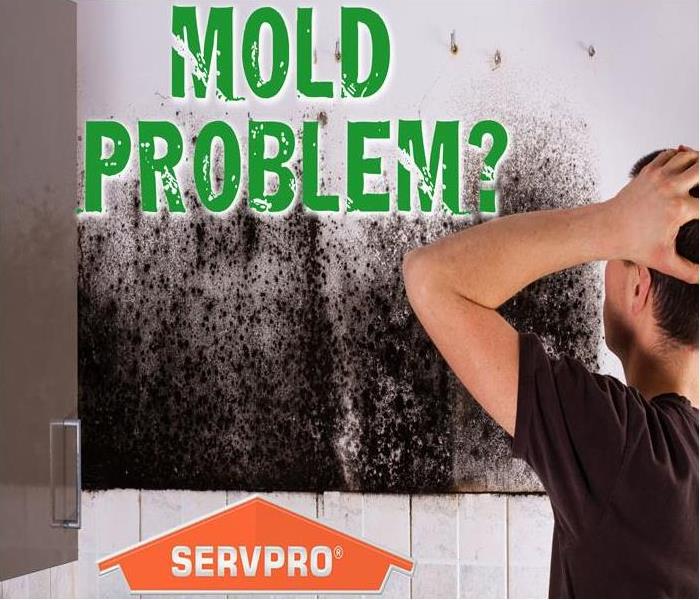 If You See Signs of Mold,
Call SERVPRO of Dane County West Today – (608) 497-3331 www,SERVPROdanecountywest.com
If You See Signs of Mold,
Call SERVPRO of Dane County West Today – (608) 497-3331 www,SERVPROdanecountywest.com
Managing Mold
When there’s a water intrusion, like a roof leak or leaking water line, mold can quickly become a problem in your home or business. Mold can cause health effects and can also cause significant damage to your property. Fortunately, SERVPRO of Dane County West Professionals have the training, protective gear, and specialized equipment necessary to handle your mold problem. Although every mold damage scenario is different and requires a unique solution, the general mold remediation process stays the same. The following steps illustrate a “typical” mold removal process.
Call the Team in Green
The mold cleanup and restoration process begins when you call SERVPRO of Dane County West, #608-497-3331. A representative will ask a series of questions to help determine the necessary equipment resources and personnel needed.
Inspection and Damage Assessment
Your commercial or residential property will be carefully inspected for signs of mold using technology designed to detect mold and hidden water sources. Mold feeds on cellulose and water and can be hidden from plain view. These conditions may require the partnership of a qualified Indoor Air Quality/Environmental Professional to test and provide a detailed air quality report.
Mold Containment
Various containment procedures will be placed to prevent the spread of mold and isolate the contaminated area with physical barriers and negative air pressure to keep the mold spores from spreading during the cleanup process.
Air Filtration
Specialized filtration equipment captures microscopic mold spores out of the air. SERVPRO of Dane County technicians utilize powerful air scrubbers and HEPA vacuums to prevent the spread of these mold spores while the mold remediation is in process.
Removing Mold and Mold-Infested Materials
The mold remediation process depends on the amount of mold growth and the types of surfaces on which mold appears. Antifungal and antimicrobial treatments will be used to eliminate mold colonies and help prevent new colonies from forming. Removing and disposing of mold-infested porous materials, like drywall and flooring, may be necessary to remediate substantial mold growth.
Cleaning Contents and Belongings
SERVPRO of Dane County West Professionals clean restorable items affected by mold. They use a variety of cleaning techniques to clean and sanitize your belongings. They are also trained to remove odors and deodorize using fogging equipment.
Restoration
Depending on the level of mold damage, drywall, subfloors, and other building materials may be removed. Restoration may involve minor repairs, such as replacing drywall, painting, and installing new carpet, or it may entail major repairs such as the reconstruction of various areas or rooms in a home or business.
If You See Signs of Mold,
Call SERVPRO of Dane County West Today – (608) 497-3331
Mold Remediation and Restoration
Mold - From the Ordinary to the Unhealthy
5/13/2019 (Permalink)
 SERVPRO of Dane County West has the training, protective gear, and specialized equipment necessary to handle your mold problem. 608-497-3331
SERVPRO of Dane County West has the training, protective gear, and specialized equipment necessary to handle your mold problem. 608-497-3331
MOLD
From the Ordinary
Fungi and mold naturally occur in our environment. In fact, over 100,000 kinds of fungi have been identified. Fungi produce some very useful results. Yeast is a type of fungi used in preparing breads, baked goods and other food products, including some alcoholic beverages. The unique flavor of blue cheese is a result of mold. An edible mushroom is simply a type of fungi, and lifesaving penicillin is a product of mold (Penicillin chrysogenum).
Even though some forms of mold can add value to our lives, other forms can be harmful. Excessive amounts of mold, different types of mold and/or exposure to molds may present health concerns for some people.
To The Unhealthy
Intrusion of water into your home or place of business can result in mold growth. Water intrusions can result from storm damage, plumbing or equipment failures, long-standing leaks and poor humidity control. When water intrusions are not addressed right away, the resulting damage can present increased risk of harmful mold growth. Some amount of mold spores are normally present in most environments. If the humidity and moisture levels in a water-damaged environment are not promptly returned to normal, mold spores may grow and multiply. Organic materials found inside building, such as wood, paper, drywall and insulation, provide food sources for mold to flourish. Excessive mold growth can lead to indoor environmental conditions that pose a health threat.
Help Is Here
In as little as 48 hours, mold can quickly become a problem in your home or business when there’s a water intrusion, like a roof leak or leaking water line. Mold can cause health effects and can also cause significant damage to your property. SERVPRO of Dane County West has the training, protective gear, and specialized equipment necessary to handle your mold problem.
Have a Mold Problem?
Call Us Today – (608) 497-3331
Mold Damage Tips - SERVPRO of Dane County West
Mold - What You Need To Know
10/1/2018 (Permalink)
 #SERVPROdanecountywest #SERVPROdcw #spdcw #SERVPROdaneco #24houremergencyservice #restoration #firedamage #cleanup #waterdamage #mold #rebuild
#SERVPROdanecountywest #SERVPROdcw #spdcw #SERVPROdaneco #24houremergencyservice #restoration #firedamage #cleanup #waterdamage #mold #rebuild
Mold has Ordinary Origins
Fungi and mold naturally occur in our environment. In fact, over 100,000 kinds of fungi have been identified. Fungi produce some very useful results. Yeast is a type of fungi used in preparing breads, baked goods and other food products, including some alcoholic beverages. The unique flavor of blue cheese is a result of mold. An edible mushroom is simply a type of fungi, and lifesaving penicillin is a product of mold (Penicillin chrysogenum).
Even though some forms of mold can add value to our lives, other forms can be harmful. Excessive amounts of mold, different types of mold and/or exposure to molds may present health concerns for some people.
To The Unhealthy
Intrusion of water into your home or place of business can result in mold growth. Water intrusions can result from storm damage, plumbing or equipment failures, long-standing leaks and poor humidity control. When water intrusions are not addressed right away, the resulting damage can present increased risk of harmful mold growth. Some amount of mold spores are normally present in most environments. If the humidity and moisture levels in a water-damaged environment are not promptly returned to normal, mold spores may grow and multiply. Organic materials found inside building, such as wood, paper, drywall and insulation, provide food sources for mold to flourish. Excessive mold growth can lead to indoor environmental conditions that pose a health threat.
Understanding Mold
Some restoration companies advertise “mold removal” and may even guarantee to remove all mold. This is a fallacy because removing all mold from a house or business is impossible; microscopic mold spores exist almost everywhere, both indoors and outdoors. Here are the facts:
- Mold is present almost everywhere, indoors and outdoors.
- Mold spores are microscopic and float along in the air and may enter your home through windows, doors, or AC/heating systems or even hitch a ride indoors on your clothing or a pet.
- Mold spores thrive on moisture. Mold spores can quickly grow into colonies when exposed to water. These colonies may produce allergens and irritants.
- Before mold remediation can begin, any sources of water or moisture must be addressed. Otherwise, the mold may return.
- Mold often produces a strong, musty odor and can lead you to possible mold problem areas.
- Even higher-than-normal indoor humidity can support mold growth. Keep indoor humidity below 45 percent.
Help Is Here
If You See Signs of Mold,
Call Us Today – (608) 497-3331
https://www.SERVPROdanecountywest.com/mold-remediation
Stop Mold Before It Gets a Start to Grow
9/17/2018 (Permalink)
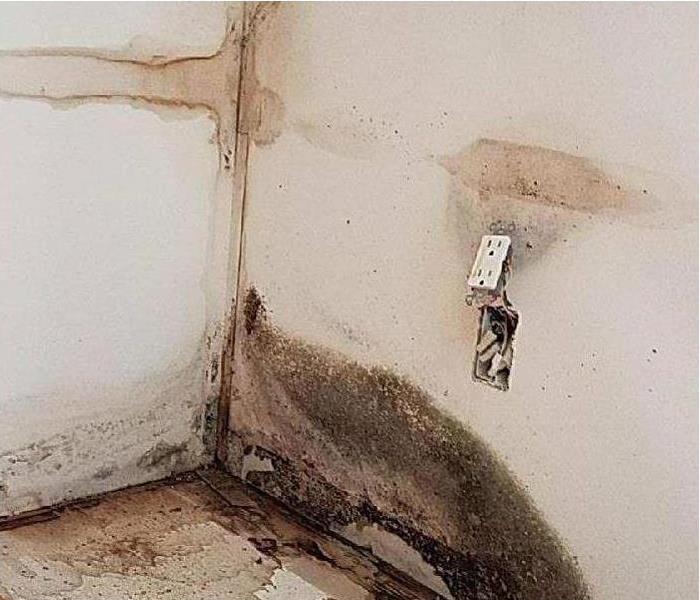 #SERVPROdanecountywest #SERVPROdcw #spdcw #SERVPROdaneco #24houremergencyservice #restoration #firedamage #cleanup #waterdamage #mold #rebuild
#SERVPROdanecountywest #SERVPROdcw #spdcw #SERVPROdaneco #24houremergencyservice #restoration #firedamage #cleanup #waterdamage #mold #rebuild
Intrusions of water into your home or place of business can result in mold growth. Water intrusions can result from storm damage, plumbing or equipment failures, long-standing leaks and poor humidity control. When water intrusions are not addressed right away, the resulting damage can present increased risk of harmful mold growth.
Take Precautions
SERVPRO of Dane County West Professionals handle water damages every day and know prompt action is required to prevent mold growth. Mold is more likely to spread when an environment has been subject to moisture for a long period of time. If your property has sustained a recent water damage, it is vital to remove excess water and dry the structure promptly. If there is an ongoing moisture problem in the building, it is important to be alert for:
- The presence of visible mold.
- Strong musty odors which may indicate mold is present.
- Any evidence of past moisture problems that might have caused undetected mold growth.
- Excessive humidity.
These conditions may require the expertise of a qualified Indoor Air Quality/Environmental Professional to inspect the building for mold growth and water damage problems.
Help Is Here
If you think you might have a mold problem, call SERVPRO of Dane County West, #608-497-3331. SERVPRO of Dane County West Professionals care about proper restoration of your structure. In most water damage situations excessive mold growth is not a problem and SERVPRO of Dane County West Professionals can safely restore your building to preloss condition.
Black Mold Defined
9/17/2018 (Permalink)
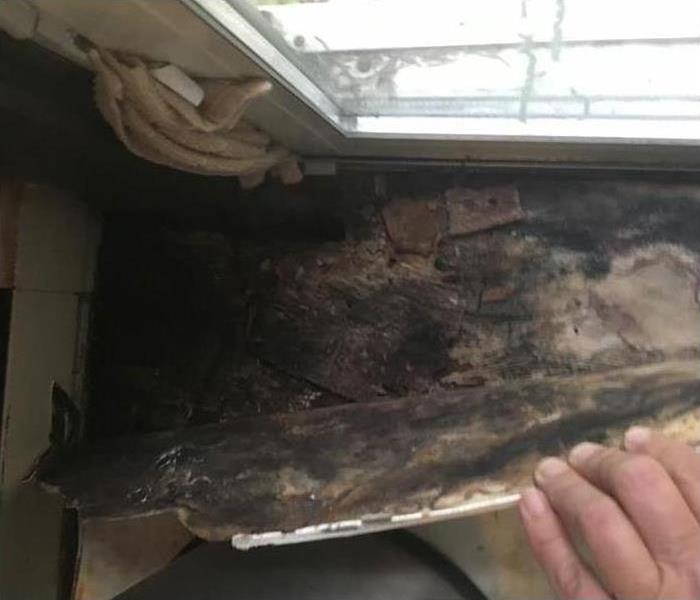 #SERVPROdanecountywest #SERVPROdcw #spdcw #SERVPROdaneco #24houremergencyservice #restoration #firedamage #cleanup #waterdamage #mold #rebuild
#SERVPROdanecountywest #SERVPROdcw #spdcw #SERVPROdaneco #24houremergencyservice #restoration #firedamage #cleanup #waterdamage #mold #rebuild
You may have seen sensational news reports that warn about the dangers of “black mold” or “toxic mold”. These reports can be alarming and confusing so it’s beneficial to get the facts to better understand mold.
Stachybotrys chartarum is the type of mold often called black mold, and it does produce allergens and irritants. However, many types of mold can produce allergens and irritants. Treat any mold with caution – stay out of affected areas and don’t touch or disturb the mold.
Learn more about mold and what to do until help arrives by visiting Mold Damage Tips.
How Do I Tell If It’s Black Mold?
Since many types of mold can cause reactions, you should contact us regardless of the color or type of mold. In many instances, multiple types of mold may exist in the same house or structure. If you suspect you have a mold problem, contact SERVPRO of Dane County West immediately.
If You See Signs of Mold, Call Us Today – (608) 497-3331
Understanding Mold
When water intrudes into your property, mold growth can start in as little as 48 hours. Consider the following mold facts:
- Mold is present almost everywhere, indoors and outdoors.
- Mold spores are microscopic, float along in the air, and may enter your home through windows, doors, or AC/heating systems or even hitch a ride indoors on your clothing or a pet.
- Mold spores thrive on moisture. Mold spores can quickly grow into colonies when exposed to water. These colonies may produce allergens and irritants.
- Before mold remediation can begin, any sources of water or moisture must be addressed. Otherwise the mold may return.
- Mold often produces a strong, musty odor, and that odor can lead you to possible mold problem areas.
- Even higher-than-normal indoor humidity can support mold growth. Keep indoor humidity below 45 percent.
http://www.SERVPROdanecountywest.com/black-mold
If you have a water and/or mold issue, call SERVPRO of Dane County West for help. #608-497-3331
What is Black Mold?
9/28/2017 (Permalink)
 Stachybotrys chartarum is the type of mold often called black mold, and it does produce allergens and irritants.
Stachybotrys chartarum is the type of mold often called black mold, and it does produce allergens and irritants.
You may have seen sensational news reports that warn about the dangers of “black mold” or “toxic mold”. These reports can be alarming and confusing so it’s beneficial to get the facts to better understand mold.
Stachybotrys chartarum is the type of mold often called black mold, and it does produce allergens and irritants. However, many types of mold can produce allergens and irritants. Treat any mold with caution – stay out of affected areas and don’t touch or disturb the mold.
Learn more about mold and what to do until help arrives by visiting Mold Damage Tips.
How Do I Tell If It’s Black Mold?
Since many types of mold can cause reactions, you should contact us regardless of the color or type of mold. In many instances, multiple types of mold may exist in the same house or structure. If you suspect you have a mold problem, contact SERVPRO of Dane County West immediately.
If You See Signs of Mold, Call Us Today – (608) 497-3331
Understanding Mold
When water intrudes into your property, mold growth can start in as little as 48 hours. Consider the following mold facts:
- Mold is present almost everywhere, indoors and outdoors.
- Mold spores are microscopic, float along in the air, and may enter your home through windows, doors, or AC/heating systems or even hitch a ride indoors on your clothing or a pet.
- Mold spores thrive on moisture. Mold spores can quickly grow into colonies when exposed to water. These colonies may produce allergens and irritants.
- Before mold remediation can begin, any sources of water or moisture must be addressed. Otherwise the mold may return.
- Mold often produces a strong, musty odor, and that odor can lead you to possible mold problem areas.
- Even higher-than-normal indoor humidity can support mold growth. Keep indoor humidity below 45 percent.
http://www.SERVPROdanecountywest.com/black-mold
If you have a water and/or mold issue, call SERVPRO of Dane County West for help. #608-497-3331
Homeowner’s and Renter’s Guide to Mold Cleanup After Disasters from the Center for Disease Control and Prevention (CDC)
9/18/2017 (Permalink)
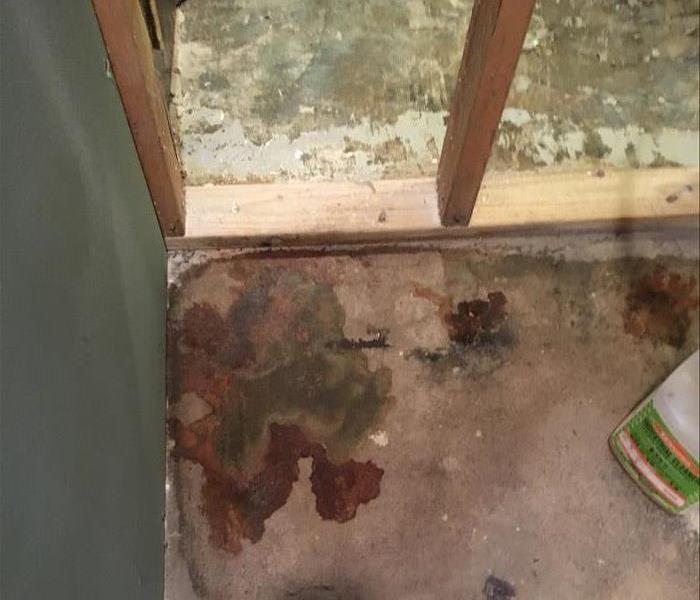 Was your home flooded? If so, and you were not able to dry your home within 24-48 hours, you should assume you have mold. #SERVPROdanecountywest
Was your home flooded? If so, and you were not able to dry your home within 24-48 hours, you should assume you have mold. #SERVPROdanecountywest
Homeowner’s and Renter’s Guide to Mold Cleanup After Disasters
https://www.cdc.gov/mold/pdfs/homeowners_and_renters_guide.pdf
Cleaning up after a flood can pose health risks. You and your family should wait to re-enter your home until professionals tell you it is safe, with no structural, electrical or other hazards.
Before you start cleanup activities, contact your insurance company and take pictures of the home and your belongings. Remember – drying your home and removing water-damaged items is your most important step for preventing mold damage.
Is There a Problem?
Was your home flooded? If so, and you were not able to dry your home (including furniture and other items) within 24-48 hours, you should assume you have mold growth. You need to completely dry everything, clean up the mold, and make sure you don’t still have a moisture problem.
You may see or smell mold on clothing, drywall, furniture, cardboard boxes, or books, but it may also be hidden under or behind items like carpet, cushions, or walls.
Mold Basics: How Molds Can Affect Your Health
Key Messages
- Wear personal protective equipment. Wear an N-95 respirator at a minimum, goggles, and protective gloves.
- Use portable generators carefully, outside and away from the home, to avoid carbon monoxide poisoning and fires.
- Ensure the mold cleanup is complete before reoccupying your home.
Exposure to mold can lead to asthma attacks, eye and skin irritation, and allergic reactions. It can lead to severe infections in people with weakened immune systems. Avoid contaminated buildings and contaminated water as much as you can.
Flood water may have carried sewage or chemicals into your home. This could expose you or your family to viruses, bacteria, disease carriers (such as mosquitoes), and parasites, as well as mold. To learn more about cleaning and disinfection go to: www.cdc.gov/healthywater/emergency/flood/standing.html.
You can protect yourself and your family from mold exposure by following these steps.
Before You Enter Any Moldy Site:
- Protect yourself and loved ones against hazards. People with breathing problems like asthma or who have weakened immune systems should stay away from moldy sites. Children should not take part in disaster cleanup work. Check for loose power lines or gas leaks. Make sure the electricity and gas are turned off. Look for sagging ceilings or floors or other structural problems. Watch out for wet, muddy, or slippery floors.
- Protect your mouth and nose against breathing in mold: wear at least an N-95 respirator. If you plan to spend a lot of time removing moldy belongings or doing work like ripping out moldy drywall, wear a half-face or full-face respirator. Basic information on using it is in OSHA’s general respiratory protection guidance.
- Protect your skin. Wear protective gloves (non-latex, vinyl, nitrile, or rubber). Do not touch mold or moldy items with bare hands.
- Protect your eyes. Wear goggles that provide complete eye protection. Choose goggles designed to keep out dust and small particles. Safety glasses or goggles that have open vent holes will not protect you against dust and small particles.
After You Leave a Mold Site:
- Protect yourself and loved ones. Shower and change your clothes. This will help you avoid carrying mold and other hazards back to your current living quarters.
Should I Do This Myself?
This job may be too difficult or dangerous for you. It may be best to get help from experienced and qualified professionals if you can. Hire a mold inspection or remediation professional affiliated with or certified by the National Environmental Health Association (NEHA), the American Industrial Hygiene Association (AIHA), the Institute of Inspection, Cleaning and Restoration Certification (IICRC), or American Council for Accredited Certification (ACAC) to inspect, repair, and restore the damaged parts of your home. Your state also may regulate mold remediation.
Sampling for mold is not usually recommended. Understanding the results can be difficult, and no matter what kind of mold is in your home, you need to clean it up and fix the moisture problem.
For more information from the CDC about mold, please visit their website:
https://www.cdc.gov/mold/faqs.htm
Don't Let Mold Grow
9/12/2017 (Permalink)
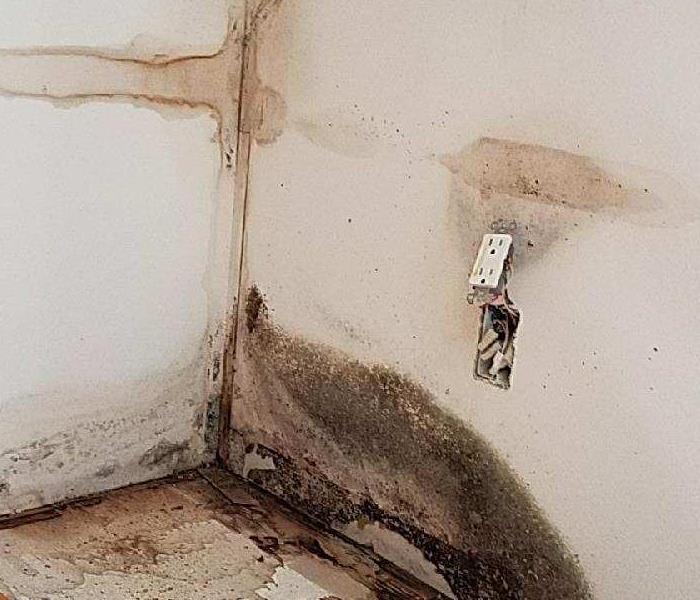 mold growth after water damage. #SERVPROdanecountywest #spdcw #608-497-3331
mold growth after water damage. #SERVPROdanecountywest #spdcw #608-497-3331
Intrusions of water into your home or place of business can result in mold growth. Water intrusions can result from storm damage, plumbing or equipment failures, long-standing leaks and poor humidity control. When water intrusions are not addressed right away, the resulting damage can present increased risk of harmful mold growth.
Take Precautions
SERVPRO of Dane County West Professionals handle water damages every day and know prompt action is required to prevent mold growth. Mold is more likely to spread when an environment has been subject to moisture for a long period of time. If your property has sustained a recent water damage, it is vital to remove excess water and dry the structure promptly. If there is an ongoing moisture problem in the building, it is important to be alert for:
- The presence of visible mold.
- Strong musty odors which may indicate mold is present.
- Any evidence of past moisture problems that might have caused undetected mold growth.
- Excessive humidity.
These conditions may require the expertise of a qualified Indoor Air Quality/Environmental Professional to inspect the building for mold growth and water damage problems.
Help Is Here
If you think you might have a mold problem, call SERVPRO of Dane County West, #608-497-3331. SERVPRO of Dane County West Professionals care about proper restoration of your structure. In most water damage situations excessive mold growth is not a problem and SERVPRO of Dane County West Professionals can safely restore your building to preloss condition.
Got Mold?
9/12/2017 (Permalink)
 If you think you might have a mold problem, call SERVPRO of Dane County West #608-497-3331.
If you think you might have a mold problem, call SERVPRO of Dane County West #608-497-3331.
MOLD
From the Ordinary
Fungi and mold naturally occur in our environment. In fact, over 100,000 kinds of fungi have been identified. Fungi produce some very useful results. Yeast is a type of fungi used in preparing breads, baked goods and other food products, including some alcoholic beverages. The unique flavor of blue cheese is a result of mold. An edible mushroom is simply a type of fungi, and lifesaving penicillin is a product of mold (Penicillin chrysogenum).
Even though some forms of mold can add value to our lives, other forms can be harmful. Excessive amounts of mold, different types of mold and/or exposure to molds may present health concerns for some people.
To The Unhealthy
Intrusion of water into your home or place of business can result in mold growth. Water intrusions can result from storm damage, plumbing or equipment failures, long-standing leaks and poor humidity control. When water intrusions are not addressed right away, the resulting damage can present increased risk of harmful mold growth. Some amount of mold spores are normally present in most environments. If the humidity and moisture levels in a water-damaged environment are not promptly returned to normal, mold spores may grow and multiply. Organic materials found inside building, such as wood, paper, drywall and insulation, provide food sources for mold to flourish. Excessive mold growth can lead to indoor environmental conditions that pose a health threat.
Help Is Here
If you think you might have a mold problem, call SERVPRO of Dane County West #608-497-3331.
 If You See Signs of Mold,
Call SERVPRO of Dane County West Today – (608) 497-3331 Proudly serving Madison, WI.
If You See Signs of Mold,
Call SERVPRO of Dane County West Today – (608) 497-3331 Proudly serving Madison, WI.





 24/7 Emergency Service
24/7 Emergency Service








